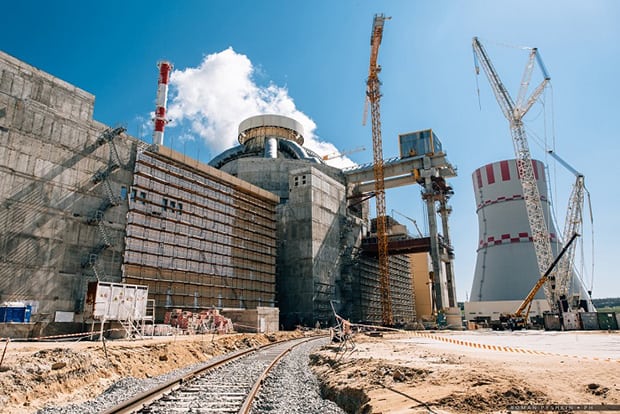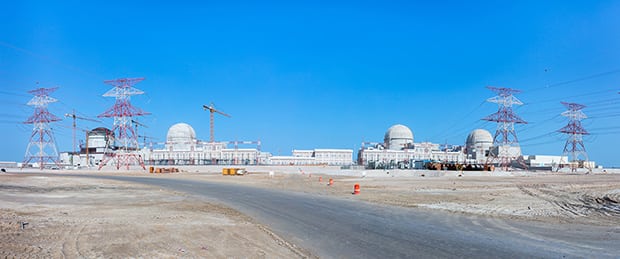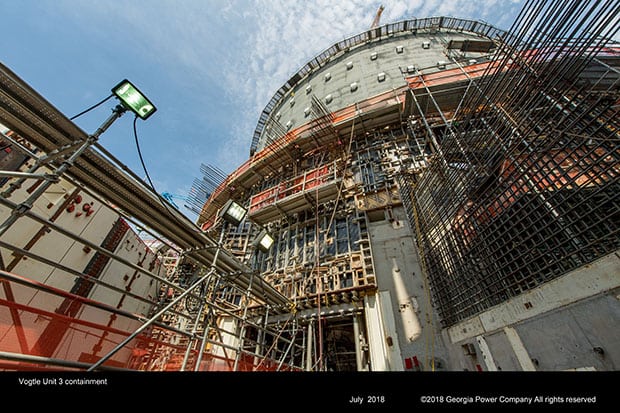Nuclear Construction Update: New Progress Made in Russia, UAE, and U.S.
Several milestones have been reached at nuclear power plant construction sites around the world including on the Leningrad II-2, Novovoronezh II-2, Barakah, and Plant Vogtle projects.
Russian Progress
At the Leningrad site, Rosatom—the Russian state atomic energy corporation—reported on August 7 that the main turbine equipment installation for Phase II Unit 2 was completed. The company said that the stator, separators, superheaters, deaerator, turbine condensers, high- and low-pressure heaters, and heat exchangers have all been installed. Work will now begin on insulation, low-current and electrical installation, and the laying of external and internal engineering networks.
Leningrad Phase I has four RBMK-1000 units, which were connected to the power grid between 1973 and 1981. Phase II will have four VVER-1200 units, two of which are currently under construction. Unit 1 was connected to the grid on March 9 and is currently in the final stages of commissioning. It was the second VVER-1200 unit to be grid connected. Novovoronezh 6 (also known as Novovoronezh Nuclear Power Plant [NPP] 2 Unit 1) was the first VVER-1200 to enter service. It entered commercial operation on February 27, 2017, and was a POWER Top Plant that year.
На Ленинградской АЭС стартовало финальное 15-суточное комплексное опробование энергоблока №1. После него сдаём блок в промышленную эксплуатацию pic.twitter.com/cfBRaUoloP
— Росатом (@rosatom) August 8, 2018
Rosatom reported on July 17 that experts from the Moscow Centre of the World Association of Nuclear Operators (WANO) completed a review of Leningrad NPP Unit 1. It said, WANO representatives monitored the activity of workers as they carried out various operational scenarios in the unit’s full-scale simulator. The team also analyzed documents and interviewed operations personnel as part of the visit.
At the Novovoronezh site, Rosatom said on August 1 that Phase II Unit 2 (Figure 1) had started cold and hot trials of equipment. The trials were expected to take about 100 days to complete.
 |
1. Moving forward. Novovoronezh II Unit 2 has begun cold and hot trial tests on plant equipment. Courtesy: Rosatom |
“We have already carried out pressure tests of the primary and secondary circuits for the pressure of 3.2 and 2.0 [megapascal] and confirmed integrity of these circuits,” Plant Manager Vladimir Povarov said in a press release. “Now, we are to switch on reactor coolant pumps and carry out necessary integrity and strength tests.”
Barakah Unit 2 Hot Tests Complete
The Emirates Nuclear Energy Corp. (ENEC) reported on August 6 that it has successfully completed hot functional testing on Unit 2 of the Barakah Nuclear Energy Plant. The company said it incorporated all lessons learned from the same test on Unit 1 in order to achieve the highest international standards of quality, safety, and efficiency. There are four units (Figure 2) currently under construction at Barakah with overall progress said to be more than 89% complete.
 |
2. Nuclear oasis. The Barakah site includes four units (from left to right, Units 4, 3, 2, and 1). Construction began on Unit 1 in 2012 with each successive unit staggered by one year. Courtesy: ENEC |
During Unit 2’s hot functional testing, ENEC worked closely with the Korea Electric Power Corp.—the joint venture partner and prime contractor for the project—and under the observation of the Federal Authority for Nuclear Regulation, the United Arab Emirates’ independent nuclear regulatory body, to achieve the major milestone.
During the testing, components were checked for thermal expansion, vibration, and wear. The results demonstrated that all systems performed in accordance with the highest quality and safety standards under normal operating conditions. Most notably, the pressurizer safety valve test, pre-core reactor coolant system flow measurement test, and main turbine system test were completed, proving that major components and systems worked as designed and met all requirements for normal operation.
Plant Vogtle Expansion Advances, but Costs Increase
Georgia Power announced on August 8 that Southern Nuclear has made significant progress on construction of Plant Vogtle Unit 3 (Figure 3) and Unit 4 since assuming project management, on behalf of the co-owners, from Westinghouse following its bankruptcy in 2017. However, the company also said that its revised capital and construction cost forecast for its share of the project has increased from $7.3 billion to $8.4 billion, based on a revised cost-to-complete estimate from Southern Nuclear. Georgia Power holds a 45.7% stake in the project, while Oglethorpe Power (30%), MEAG Power (22.7%), and Dalton Utilities (1.6%) hold the remaining shares.
 |
3. First-of-a-kind. This image shows Vogtle Unit 3’s containment under construction in July 2018. Courtesy: Georgia Power |
More than 7,000 workers are reportedly on-site working to complete the new units. Milestones during the past 60 days included a major concrete placement lasting more than eight continuous hours inside the Unit 3 shield building, and the placement of a 26-ton Q233 piping module—said to be a critical piece of the overall passive core cooling system—inside the containment vessel for Unit 4, which will now allow large quantities of specialized piping to be installed.
According to Georgia Power, project leadership made a series of decisions, such as providing craft labor incentives to both attract and retain adequate staffing levels, and increasing field supervision and engineering oversight, in an effort to lower project risk and maintain project momentum.
“While there will always be challenges in building the first new nuclear units in this country in more than 30 years, we remain focused on reducing project risk and maintaining the current project momentum in order to provide our customers with a new carbon-free energy source that will put downward pressure on rates for 60 to 80 years,” Paul Bowers, CEO of Georgia Power, said in a press release.
Georgia Power continues to anticipate in-service dates of November 2021 for Unit 3 and November 2022 for Unit 4.
—Aaron Larson, executive editor (@AaronL_Power, @POWERmagazine)